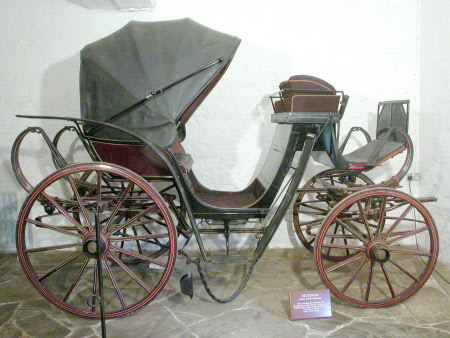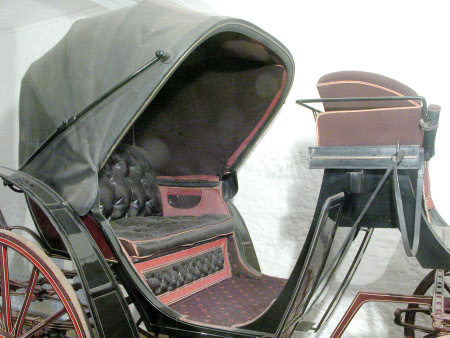Victoria
W. and F. Thorn
Category
Carriages & other vehicles
Date
circa 1850
Materials
Painted wood body with leather hood, wool cloth and morocco leather upholstery and four iron shod wheels.
Measurements
317.5 x 162.5 x 218.5cm (10ft 5in x 5ft 4in x 7ft 2in)
Place of origin
London
Order this imageCollection
Charlecote Park, Warwickshire
NT 534200
Caption
Victoria carriages were at their most popular during the reign of Queen Victoria. The body of the carriage is low to the ground making them easy to get in and out of. The fashion for the ladies during the late nineteenth century involved them wearing some fairly wide skirts supported by a hoop made of wire. The wide entrance space on the side of a Victoria allowed the hoops to be manouvered. The Panel Boot Victoria had a space to the rear of the carriage where a grooms or footmans seat could be placed. This carriage was built by W & F Thorn of London, circa 1850, and is painted in maroon with red and white lining on the wheels and undercarriage.
Summary
Panel Boot Victoria built by W & F Thorn circa 1850. Panel Boot Victoria (four wheels) for a pair of horses. The body is cut-under and has a curved back panel. The boot of this carriage is so shallow that it is hardly a true panel boot. Most Victorias are mounted on elliptic springs but, unusually, this example is suspended from C springs and under springs. The footboard is on moulded brackets and there is a fixed heel board and a drop down children’s seat in the back of the boot. The head is made of leather on straight joints, the body panels, wheels and carriage are painted maroon with a medium red line edged with fine white lines.
Full description
The Victoria is a carriage whose country of origin is unknown. Its design may have originated in France or England, but it did become very popular in England during Queen Victoria's reign. Queen Victoria favoured this type of carriage as its body was low to the ground therefore making it easy to get in and out of in the then fashion of dresses with wide skirts. Victorias are usually described as panel boot or skeleton boot examples, depending on the construction of the boot. A panel boot provides a useful locker, with the access behind the seat fall of the coachman's seat. A panel boot also provides the facility to fit an additional small hinged seat, which is stowed in a recess in the back of the boot when it is not in use. The carriage was built by W&F Thorn who established their business in Oxford Street in 1824, moved to Great Portland Street in the 1850's and remained in business until the 1920's.
Provenance
Given to the National Trust in 1945.
Marks and inscriptions
On front nearside axle cap.: W & F THORN LONDON On front offside axle cap.: W & F THORN LONDON On the rear nearside axle cap.: W & F THORN LONDON On rear offside axle cap.: W & F THORN LONDON
Makers and roles
W. and F. Thorn , coach builder W and F. Thorn , coach builder
References
Carriage Driving, Dec 1997 – Jan 1998, pp.32-33

